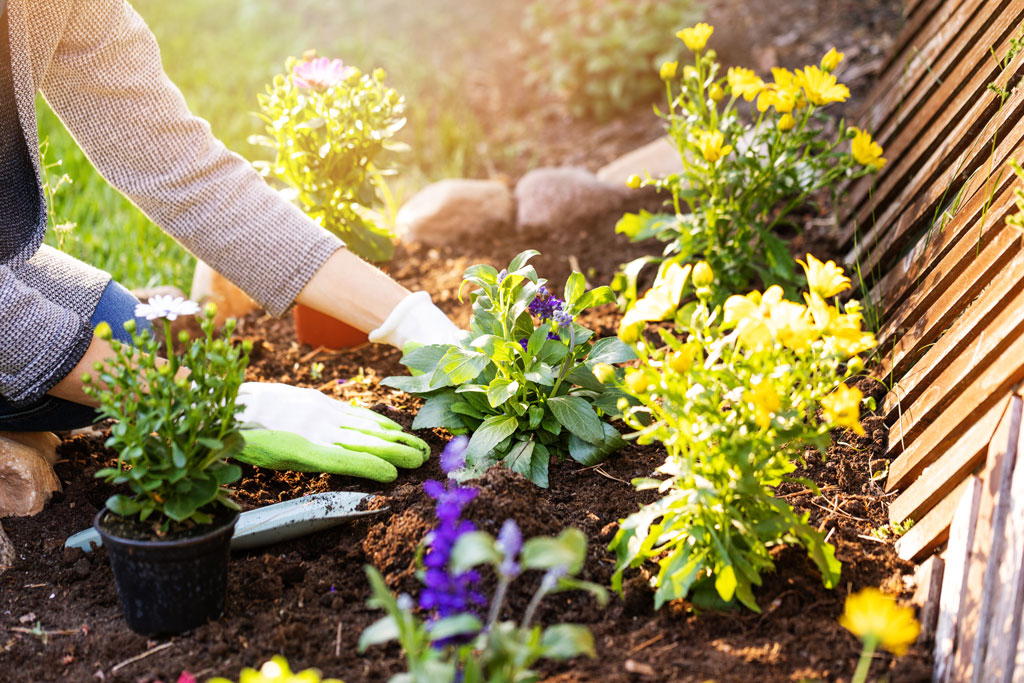As the weather gets warmer, we’ll be spending more time in our gardens – not just soaking up the sunshine, but planting and pruning. Gardening is naturally a sustainable activity, but there are ways to be more environmentally-conscious, from reducing water wastage to creating your own compost heap.
The Best Walks in the UK for Spring
Here Aidan Bell, co-founder of sustainable materials company Envirobuild, shares his top tips for creating a more eco-friendly garden…

GettyImages
Cut out pesticides
Entirely cutting out pesticides is a good place to start; their overuse is one of the factors that has provoked a catastrophic decline of insect populations. This not only affects the animals which feed on them, but also has disastrous consequences for our ecosystems which ultimately supply us with clean air, water and food. Instead try companion planting, a natural method of pest control which involves growing mutually beneficial crops together. For example, French marigolds emit a strong odour which discourages greenfly and blackfly, making them the perfect companion for tomatoes, beans and sweetcorn. Carrots and leeks are also a good pairing: leeks ward off carrot fly while carrots repel leek moth.
Buy peat-free compost
If you buy compost, choose one that is completely peat-free. Peatlands plays a vital role in mitigating climate change and stabilising the carbon cycle through their storage of carbon. Taking hundreds of years to form, they can be destroyed in a matter of days for our use. Alternatives to peat include coir (coconut fibre), wood fibre and other organic matter.

GettyImages
Create a compost heap
If you have more space, creating your own compost heap is a great way to recycle food and other organic waste into a rich and healthy fertiliser for your soil. Repurpose something you already have, or find second-hand, rather than buying a brand-new compost bin. Get creative with reusing old household products in your garden. Try turning cardboard tubes from kitchen roll and pieces of newspaper into biodegradable seedling pots. Simply cut to size and fold over at the bottom, planting them directly into soil.

Buy sustainable furniture
For finishing touches look at investing in more sustainable garden furniture options which divert materials from landfill while creating long-lasting solutions. EnviroBuild’s all-weather Rattan garden furniture, made using recycled polyethylene, is a luxury and sustainable addition to any patio.

GettyImages
A few more smart swaps and tips
- Repellents containing metaldehyde can cause significant harm to wildlife and pollute rivers. Instead, use wool based mats and copper tapes – these help to deter slugs from spoiling your crops and flowers.
- Swap harsh chemical fertilisers for organic alternatives. Not only are these more eco-friendly, they can help your plants last longer.
- Try to reduce unnecessary water wastage. Water your plants the correct amount, get a rainwater butt and consider investing in an eco-friendly watering system as opposed to a traditional hosepipe. You can also buy large pots for plants so they don’t dry out as quickly.
- Fill your garden with native plants, such as native wildflowers, which are ideal for attracting bees and butterflies and are often more resistant to pests than non-natives.
- Grow your own food – it’s better for the environment, and tastes better too.
- Switch to solar power lighting. Garden centres, high street shops and Amazon sell a wide range of garden and patio products such as decorative lanterns, rope-handled jars, fairy lights and fixed wall lights. It’s better for the environment, you’ll save on your energy bill, and the garden will look magical when lit up in the evenings.
The Best Gardens in the UK | Highgrove: A Visit to the Royal Gardens
The post Sustainable Gardening: A Guide appeared first on What's On? By C&TH.
Sofa giá rẻ
https://sofagiarehcm.hatenablog.com
0975488488
981 Huỳnh Tấn Phát, P. Phú Thuận, Quận 7, TP Hồ Chí Minh
Sofa giá rẻ
Không có nhận xét nào:
Đăng nhận xét